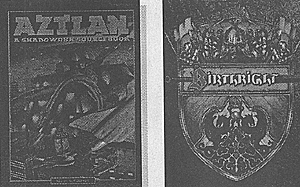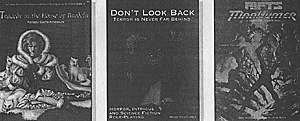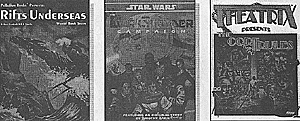 Role Call is a new column devoted to recent releases in the
gaming industry. Each month, a new series. of products, systems and.
supplements will be displayed and discussed briefly.
Role Call is a new column devoted to recent releases in the
gaming industry. Each month, a new series. of products, systems and.
supplements will be displayed and discussed briefly.
The column is designed to give gamers an idea of what to expect in the product, beyond the simple "back page plug" on the cover. Role Call is not a series of reviews; the authors are not attempting to gauge the quality of the work or render an opinion on its overall usefulness.
Instead, they simply give readers an idea of what they're in for. New rules and settings will be given an overview', pertinent designers and supplemental material will be mentioned, and an overall summation of the product will be included.
Role Call has no bias towards any particular system or company. Both large and small products will be covered, and no more than two products from any one company will be discussed in the same issue.
If you are interested in seeing a rulebook or game setting appear in Role Call, please send your suggestions to the SHADIS offices. We always consider reader interests when assembling this column.
Aztlan is the South of the Border Source book for FASA's Shadowrun RPG. Written by the late Nigel D. Findley, it centers around the growth and development of the Azdan nation out of the ashes of old Mexico. The 184 page rulebook contains extensive information on running campaigns in Azdan and a detailed description of its controlling interest, the powerful mega- corp, Aztechnology. As in many other Shadowrun sourcebooks, the information appears in the format of an "internet discussion" of various Shadowrunners, who comment on a series of recently stolen corporate files.
Aztlan has the distinction of being the world's only corporate nation: elections, government services and all practical facets of society are controlled by Aztechnology. A detailed history of the company is included, from its beginning as an extension of the Columbian drug cartels to its cut. rent,status as the most powerful corporation on Earth. In addition, its business practices, corporate structure and key personnel are discussed in depth. The sourcebook also includes a more "traditional" history of the supposedly autonomous government, including its gradual absorbtion into Aztechnology and its current status in relation to other North American states. Information on geography, politics, day to day life, and the capital city of Tenochtitldn (formerly Mexico City) is provided as well. The book closes with a color map of the capital.
A rebellion of Native Americans against the ruling government has exploded in the Yukatin jungles, and the text covers the conflict in considerable depth. Players are provided with ideas on "inserting" their characters into the country, and GMs receive several ways on how to keep them busy once they get there. Finally, the book devotes an entire chapter to the specifies of the Aztec religion (revived by Aztechnology and currently the dominant faith), and includes rules for using native Aztec magic in your campaign. Eight color paint. ings have been inserted into the center spread, designed to complement each of the myriad subjects the sourcebook entails.
Birthright is a new campaign set from TSR, designed to bring the AD&D game closer to its wargaming roots. Rather than normal adventurers, players create the rulers of entire kingdoms who must guide their realms and their people through a maze of, intrigue, diplomacy and feudal warfare.
Thousands of years ago, on the continent of Cerilia, the forces of Good and Evil engaged in a cataclysmic conflict that marked the end of an era. The Gods themselves descended from heaven to take part in the battle, and the fury of their wrath was such that their very essences drained out of them like blood. The forces of Good won the day, but the old gods were destroyed in the process, the core of their beings spent. In their place rose new gods, mortals on the battlefield who had been imbued with divine essences. Players in Birthright are the descendents of these new gods, noble rulers with holy blood flowing in their veins. They must maneuver their kingdoms between aggressive neighbors, internal politics, and the constant threat of the awnsheghlien (mortals twisted and warped into hellish monsters by the essences of the evil gods) to expand and become more powerful.
The boxed Birthright set contains three rulebooks describing the setting and giving rules for play. The Atlas of Ceritia presents a brief overview of the people and history of the continent. The Rulebook discusses how to create noble characters, how to govern kingdoms, and how to conduct feu~ dal warfare. And The Ruins of Empire book describes the various kingdoms of Cerilia in detail, some of which are designed for players to rule. In addition, the box contains two large full color maps illustrating Cerilia, a set of War Cards designed to help resolve military clashes, a War Chest for storing the cards, twelve sheets containing reference material and stars on major awnsheghlien, and a new GM's Screen specifically designed for Birthright. Several supplements have already been released for the the setting, and TSR promises more in the near future.
 Duke Aldriv III has been murdered and his
brother Cardor has mysteriously vanished. Could he be
the killer? Or is he merely fleeing before the assassins
can target'him next? Cardor 's son, Mordeln, needs the
characters' help to find out. Together, they must brave the
sea village of Yelden, the dungeons of the Duke's castle,
the humanoidinfested borderlands of two warring
kingdoms and the sinister domain of a mysterious
werefox to locate the Prince and restore order to the
Dukedom.
Duke Aldriv III has been murdered and his
brother Cardor has mysteriously vanished. Could he be
the killer? Or is he merely fleeing before the assassins
can target'him next? Cardor 's son, Mordeln, needs the
characters' help to find out. Together, they must brave the
sea village of Yelden, the dungeons of the Duke's castle,
the humanoidinfested borderlands of two warring
kingdoms and the sinister domain of a mysterious
werefox to locate the Prince and restore order to the
Dukedom.
Tragedy in the House of Brodeln is an adventure module set in Kenzer and Company's Kingdoms of Kalamar fantasy setting. It is compatible with TSR's Advanced Dungeons and Dragons, but can be used in conjunction with any high fantasy system. Indetended for beginning characters, it sets the stage in a seaside Dukedom where the ruling family has fallen under a mysterious curse. It is up to the players to discover the root of the evil before the entire line is wiped out.
The fifty-six page module is designed to he run quickly and with a minimum of hassle. Seventeen pictures are included in the book as part of Kenzer & Co's ImageQuest system: the GM shows the players a particular picture during a particular period of the adventure. In addition, five starter characters are provided for an easy start, and the adventure descriptions are boxed for clarity and readability. A family tree helps GMs determine the lineage of the ruling nobles, and key NPCs are described in detail. Maps of castles, villages and goblin mines have been inserted, and numerous player handouts are provided in addition to the ImageQuest illustrations. Future products in the Kingdoms of Kalamar line are promised.
Don't Look Back: Terror is Never Far Behind is a modern horror role-playing game from Mind Ventures Games. Players create characters in a world which appears normal on the surface, but contains dark and evil things prowling just beyond the view of humanity. Characters comes from a variety of modem backgrounds (government agents, priests, teachers, etc.), and their ultimate role in the campaign is decided upon by the particular group of players.
Don't Look Back is designed with beginning role-players in mind. The 160 page rulebook guides readers through character creation process, skill rolls and combat, and designing adventures within the game's ascribed genre, taking care to clarify and explain the particular nuances of the rules. Tips on atmosphere and story development are spread throughout the work, and several ready-to,play characters are included in order to facilitate a rapid entrance into the gaming world. An appendix of charts and a brief index are provided to help locate information easily.
Background descriptions have deliberately been left vague; GMs are encouraged to fit their own concepts and ideas into the system provided. The basic concept assumes that the characters have seen things they shouldn't have (such as a vampire attack, a UFO abduction, or a government experiment gone wrong), and are forced to deal one way or another with the consequences. Statistics for a variety of supernatural horrors are included, as are descriptions of several sinister global organizations (the Men in Black, the hidden monsters, etc.) The GM is encouraged to use them as he or she sees fit, and a creation system is provided to bring "homegrown" terrors into the game. A pair of flesheater adventures close the book, providing foundations for a campaign and ideas on how to take the material in a specific direction (i.e., gothic horror, a government conspiracy, etc.)
The first clash between the Terrains and Aglians resulted from a misunderstanding. Horrified at what they perceived as the Terrans' wanton brutality, the peace- loving Algians designed a series of robots called Manhunters - to contain their adversaries. The Manhunters were programmed to match humanity's perceived cleverness, adaptability and deceptive cruelty in every possible manner. Their initial raids against the Terran advance went very well: the humans were stopped in their tracks and forced to retreat. Satisfied the Terrans had teamed their lesson, the Aglians issued the recall order to their robotic troops. Then something went wrong...
Rifts: Manhunter is an official supplement for Palladium's cross-genre role playing game, published independently by Myrmidon Press. It incorporates the world of Myrmidon's Manhunter RPG into the Rifts Multiverse, and can be run as an expansion to Rifts or as a stand-alone science fiction setting using Palladium's Megaverse rules. Based very loosely on James Cameron's Terminator films, Manhunter takes place in the far future, where man has colonized the stars and made contact with a dozen alien races. A breed of sentient machines, unwittingly unleashed by the Aglians, now threatens all Terran civilization. Horrified by their mistake, the Aglians have made peace with their former enemies and created an alliance against the Manhunter threat. The Aglian-Terran joint government now stands at the forefront of interplanetary politics, and forms a strong bastion against any incursions by the murderous machines.
The 210 page rulebook contains background information on the Manhunter universe, rules for tying it into the Rifts multiverse and ideas on how to run adventures in either locale. Descriptions and statistics for a dozen alien races are included, as well as detailed information on various corporations, guilds and secret societies. Twenty new character classes are provided, for use within the Manhunter universe or other Rifts locations. New technologies, vehicles and weapons are described in thorough detail, and stats are given for eight models of fearsome Manhunter robots. Future supplements set in the Manhunter universe are planned for release by Myrmidon Press.
 The kingdoms and conflicts of Rifts
have stretched across the globe, hut a large
chunk of the Earth's surface has remained
unexplored. The dimensional gates and alien
marauders of the Rifts universe have not
limited themselves to dry land, yet the vast
worlds beneath the waves have remained
mysterious and impenetrable. Until now.
Rifts: Underseas has appeared to bring
the vast underwater world to life.
The kingdoms and conflicts of Rifts
have stretched across the globe, hut a large
chunk of the Earth's surface has remained
unexplored. The dimensional gates and alien
marauders of the Rifts universe have not
limited themselves to dry land, yet the vast
worlds beneath the waves have remained
mysterious and impenetrable. Until now.
Rifts: Underseas has appeared to bring
the vast underwater world to life.
Written by Rifts creator Kevin Siembieda and C.J. Carella, the 216 page rulebook discusses over a dozen new species and nations living beneath the wave. Most prominent among these are the forces of the L)rd of the Deep, an alien being whose grasp can span the globe and whose appearance has given credence to legends of the Kracken. Opposing him and his minions are the Whale Singers; a group of "biformed" whale-human crossbreeds that have survived his hideous transformation magic. Other forces detailed include the Naut'Yll, an imperialistic race of amphibians bent on conquest; Tritonia, a floating city that has survived from pre-Rifts days; and the New Navy, surviving descendents of the old U.S. Navy who control their ancestors' pre-Rifts technology. In addition, supplementary information is included on Atlantis, Triax, and other powers from earlier Rifts products.
The text provides thirty new O.C.C.s and R.C.C.s from these new forces and elsewhere. Rules are also give for playing dolphins and whales as PCs, in addition to more "traditional" human and D-bee races. Stars for numerous underwater bionics, weapons and vehicles are included, as are rules for new underwater magic. These rules contain over forty magic spells related to the ocean, in addition to new "whale song" magic connected to the Whale Singers. The book also contains discussions of underwater ley lines, Dead pools, Gene-splicer abommations, and the six "magic triangles" located throughout Earth's seas. Additional products detailing more of the planet's underwater inhabitants are promised in the near future.
Four years after the Battle of Endor, a New Republic task force arrives on the backwater planet of Kal'Shebbol in the Kethol sector. The Imperial forces there, under the command of renegade war. lord Moff Same, put up stiff resistence. In the midst of the fighting, a team of New Republic comman. does infiltrate Same's headquarters in an attempt to capture him and deactivate the energy field protecting the planet. Same, however, manages to escape aided by a mysterious form of artifacts known only as "Dark Stryder technology." The Republic, hard pressed in other sectors, sends a rag-tag crew aboard a single modified frigate to try and track him down...
Star Wars: The DarkStryder Campaign is the first in a new series of supplements for West End's popular RPG. Players take the role of one of ten characters - the command staff of the frigate FarStar, charged with hunting down Moff Same and discovering the source of his DarkStryder technology. They are out on the fringes of the galaxy, cut off from the bulk of the New Republic govern. ment and forced to utilize their limited resources in the fulfillment of their mission. Republic operatives, local civilians and even Imperial sympathizers have all found themselves aboard the Far$tar, forced to work together in order to survive. Numerous dangers, both internal and external, threaten the mission on all fronts, and Same himself has planned a few surprises for his pursuers.
The boxed set contains background material the GM needs to begin a campaign. The ninety-six page sourcebook covers the background of the setting, stats and detailed descriptions of the principal characters and a 16 page short story by author Timothy Zahn. The Adventure Book contains six short adventures designed to launch the DarkStryder campaign. In addition, a set of fifty-six punch out cards (giving quick stats on characters and ships) is included, as well as a map detailing the deck plans of the FarStar. Future products and campaign developments are planned for release over the next year.
Theatrix: the Core Rules (Backstage Press) presents a new game system which encourages cinematic roleplaying. Characters are larger-than-life, battling against monstrous evil and seemingly unkillable foes as the Director leads them through his Script.
Theatrix is a dice optional system; random results are available for those who want them but are not encouraged. Flowcharts are copious, and attempt to cover results for almost every situation and skill level. Description is king; everything, from scene-setting background, through results of actions, all the way down to the various kinds of ways characters can be hurt, has at least some sort of description associated to heighten the impression of "being there."
Characters have numerical ratings in Attributes and Skills (ranked from one to ten on a logarithmic scale; three is Average or Competent). They also have Descriptors, words or phrases which describe the character's background, and Personality Traits. Descriptors and Personality Traits may be Activat. ed during the adventure to gain an automatic success in the appropriate area, or can sit in the background informing the players characterization.
Although the mechanics are important, they exist to support the more important aim of Theatrix, the attitude towards roleplaying. Whatever genre you choose to play in, the common thread running through any Theatrix game is capital-C Cinematic: superhuman feats, last-minute dives for cover as the bomb goes off behind you, fistfights on the wing of a biplane, harrowing plot twists and the narrowest of escapes.
Theatrix: the Core Rules is a 144-page softcover; the final page promises "Embrace Tiger/Return to Mountain," an Oriental backgrounds sourcebook which is, inevitably, "Coming Soon to a Store Near You."
Back to Shadis #21 Table of Contents
Back to Shadis List of Issues
Back to MagWeb Master List of Magazines
© Copyright 1995 by Alderac Entertainment Group
This article appears in MagWeb (Magazine Web) on the Internet World Wide Web.
Other military history articles and gaming articles are available at http://www.magweb.com